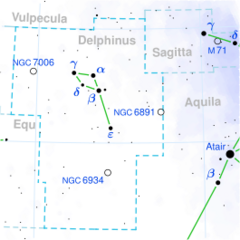Astronomy:Iota Delphini
| Observation data Equinox J2000.0]] (ICRS) | |
|---|---|
| Constellation | Delphinus |
| Right ascension | 20h 37m 49.1198s[1] |
| Declination | +11° 22′ 39.6308″[1] |
| Apparent magnitude (V) | 5.42±0.01[2] |
| Characteristics | |
| Spectral type | A1 IV[3] |
| U−B color index | +0.03[4] |
| B−V color index | +0.03[4] |
| Astrometry | |
| Radial velocity (Rv) | −3.9±0.9[5] km/s |
| Proper motion (μ) | RA: +38.867[1] mas/yr Dec.: −8.609[1] mas/yr |
| Parallax (π) | 16.6478 ± 0.0728[1] mas |
| Distance | 195.9 ± 0.9 ly (60.1 ± 0.3 pc) |
| Absolute magnitude (MV) | 1.62[6] |
| Orbit[7] | |
| Period (P) | 11.039 days |
| Eccentricity (e) | 0.23 |
| Periastron epoch (T) | 2422139.862 |
| Argument of periastron (ω) (secondary) | 61.8° |
| Semi-amplitude (K1) (primary) | 26.0 km/s |
| Details | |
| Mass | 2.47[8] M☉ |
| Radius | 1.9[9] R☉ |
| Luminosity | 23[10] L☉ |
| Surface gravity (log g) | 4.29[6] cgs |
| Temperature | 9,130[10] K |
| Metallicity [Fe/H] | −0.25[11] dex |
| Rotational velocity (v sin i) | 28[12] km/s |
| Age | 225[10] Myr |
| Other designations | |
| Database references | |
| SIMBAD | data |
Iota Delphini (ι Del, ι Delphini) is a star in the constellation Delphinus. It has an apparent magnitude of about 5.4, meaning that it is just barely visible to the naked eye. Based upon parallax measurements made by the Gaia spacecraft, this star is located at a distance of 196 light years.
Iota Delphini's spectral type is A1IV, meaning it is an A-type subgiant.[14] Observations of the star's spectrum reveal a periodic Doppler shift. This means that Iota Delphini is a spectroscopic binary with a period of 11 days and an eccentricity of 0.23.[7] However, almost no information is known about the companion star.
Iota Delphini appears to be an Am star,[6] also known as a metallic-line star. These types of stars have spectra indicating varying amounts of metals, like iron.[15] Observations of Iota Delphini's spectrum have showed lower amounts of calcium and higher amounts of iron than usual.[6]
References
- ↑ Jump up to: 1.0 1.1 1.2 1.3 Brown, A. G. A. (2021). "Gaia Early Data Release 3: Summary of the contents and survey properties". Astronomy & Astrophysics 649: A1. doi:10.1051/0004-6361/202039657. Bibcode: 2021A&A...649A...1G. Gaia EDR3 record for this source at VizieR.
- ↑ Høg, E.; Fabricius, C.; Makarov, V. V.; Urban, S.; Corbin, T.; Wycoff, G.; Bastian, U.; Schwekendiek, P. et al. (March 2000). "The Tycho-2 catalogue of the 2.5 million brightest stars". Astronomy and Astrophysics 355: L27–L30. ISSN 0004-6361. Bibcode: 2000A&A...355L..27H.
- ↑ Abt, Helmut A.; Morrell, Nidia I. (July 1995). "The Relation between Rotational Velocities and Spectral Peculiarities among A-Type Stars". The Astrophysical Journal Supplement Series 99: 135. doi:10.1086/192182. ISSN 0067-0049. Bibcode: 1995ApJS...99..135A.
- ↑ Jump up to: 4.0 4.1 Mermilliod, J.-C. (1986). "Compilation of Eggen's UBV data, transformed to UBV (unpublished)". Catalogue of Eggen's UBV Data. Bibcode: 1986EgUBV........0M. http://cdsads.u-strasbg.fr/cgi-bin/nph-bib_query?1986EgUBV........0M&db_key=AST&nosetcookie=1.
- ↑ Wilson, Ralph Elmer (1953). "General catalogue of stellar radial velocities.". Carnegie Institute Washington D.C. Publication: 0. Bibcode: 1953GCRV..C......0W.
- ↑ Jump up to: 6.0 6.1 6.2 6.3 Stateva, I.; Iliev, I. Kh.; Budaj, J. (2012). "Abundance analysis of Am binaries and search for tidally driven abundance anomalies - III. HD 116657, HD 138213, HD 155375, HD 159560, HD 196544 and HD 204188". Monthly Notices of the Royal Astronomical Society 420 (2): 1207–1216. doi:10.1111/j.1365-2966.2011.20108.x. Bibcode: 2012MNRAS.420.1207S.
- ↑ Jump up to: 7.0 7.1 Pourbaix, D. et al. (2004). "SB9: The ninth catalogue of spectroscopic binary orbits". Astronomy and Astrophysics 424 (2): 727–732. doi:10.1051/0004-6361:20041213. Bibcode: 2004A&A...424..727P.
- ↑ De Rosa, R. J. et al. (January 2014). "The VAST Survey - III. The multiplicity of A-type stars within 75 pc". Monthly Notices of the Royal Astronomical Society 437 (2): 1216–1240. doi:10.1093/mnras/stt1932. Bibcode: 2014MNRAS.437.1216D.
- ↑ Stassun, Keivan G. et al. (9 September 2019). "The Revised TESS Input Catalog and Candidate Target List". The Astronomical Journal 158 (4): 138. doi:10.3847/1538-3881/ab3467. ISSN 0004-6256. Bibcode: 2019AJ....158..138S.
- ↑ Jump up to: 10.0 10.1 10.2 Launhardt, R.; Henning, Th.; Quirrenbach, A.; Ségransan, D.; Avenhaus, H.; Van Boekel, R.; Brems, S. S.; Cheetham, A. C. et al. (2020). "ISPY-NACO Imaging Survey for Planets around Young stars. Survey description and results from the first 2.5 years of observations". Astronomy and Astrophysics 635: 635. doi:10.1051/0004-6361/201937000. Bibcode: 2020A&A...635A.162L.
- ↑ Anders, F.; Khalatyan, A.; Chiappini, C.; Queiroz, A. B.; Santiago, B. X.; Jordi, C.; Girardi, L.; Brown, A. G. A. et al. (1 August 2019). "Photo-astrometric distances, extinctions, and astrophysical parameters for Gaia DR2 stars brighter than G = 18". Astronomy and Astrophysics 628: A94. doi:10.1051/0004-6361/201935765. ISSN 0004-6361. Bibcode: 2019A&A...628A..94A.
- ↑ David, Trevor J.; Hillenbrand, Lynne A. (2015). "The Ages of Early-Type Stars: Strömgren Photometric Methods Calibrated, Validated, Tested, and Applied to Hosts and Prospective Hosts of Directly Imaged Exoplanets". The Astrophysical Journal 804 (2): 146. doi:10.1088/0004-637X/804/2/146. Bibcode: 2015ApJ...804..146D.
- ↑ "iot Del". SIMBAD. Centre de données astronomiques de Strasbourg. http://simbad.u-strasbg.fr/simbad/sim-basic?Ident=iot+Del.
- ↑ Allen, J. S.. "The Classification of Stellar Spectra". http://www.star.ucl.ac.uk/~pac/spectral_classification.html. Retrieved 1 January 2014.
- ↑ Am star , The Internet Encyclopedia of Science, David Darling. Accessed on line August 14, 2008.
 |


